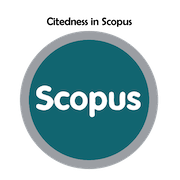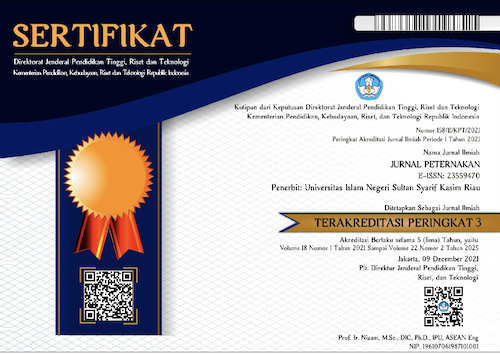Korelasi Bobot Potong dengan Produksi Non Karkas yang Bernilai Ekonomi pada Kambing Jawarandu Jantan Muda
Abstract
ABSTRAK. Selain karkas, terdapat bagian non karkas ternak yang dapat dimanfaatkan. Bagian non-karkas kambing yang bernilai ekonomi dan dapat dikonsumsi (edible portion) adalah kepala, kaki, organ dalam (visera) dan kulit. Indikator tingginya produksi non-karkas dapat dilihat dari bobot potong yang dihasilkan. Penelitian ini bertujuan untuk mengevaluasi produksi non karkas yang bernilai ekonomis melalui penilaian bobot potong pada kambing Jawarandu Jantan Muda. Sebanyak 100 ekor Kambing Jawarandu Jantan Muda berumur 6–8 bulan digunakan sebagai sampel dan diambil secara acak (purposive sampling) di Kota Salatiga. Parameter yang diukur meliputi bobot potong, bobot badan kosong, dan komponen non karkas yang terdiri dari kepala, visera, kaki, kulit. Data yang diperoleh dianalisis menggunakan analisis korelasi antara bobot potong dengan komponen non karkas. Hasil penelitian menunjukkan bahwa rata-rata bobot potong yang diperoleh adalah 21,4 kg, bobot badan kosong 16,6 kg (77,1%), bobot non karkas 10,8 kg (50,4%), bobot kepala 1,5 kg, bobot kulit 1,7 kg dan bobot visera 4,9 kg. Korelasi bobot potong terhadap bobot non karkas adalah 0,92 (P<0.01); bobot potong terhadap bobot kepala adalah 0,87 (P<0.01); bobot potong terhadap kaki adalah 0,78 (P<0.01); bobot potong terhadap kulit adalah 0,85 (P<0.01); dan bobot potong terhadap visera adalah 0,83 (P<0.01). Kesimpulannya adalah bobot potong sangat berpengaruh terhadap bobot non karkas, baik kepala, kaki, kulit dan visera. Rumus sederhana untuk menduga bobot non-karkas yang bernilai ekonomi pada kambing Jawarandu jantan muda adalah y = 0,4643x + 0,8138.
Kata kunci: kambing, Jawarandu, non-karkas
The Correlation Between Slaughter Weight and Non-Carcass Production which Has Economic Value in Young Male Jawarandu Goats
ABSTRACT. Apart from carcasses, there are non-carcass parts of livestock that can be used. Non-carcass parts of goats, that are of economic value and can be consumed (edible portion) are the head, legs, internal organs (viscera) and skin. Indicators of high non-carcass production can be seen from the production of carcasses produced. This study aimed to evaluate non-carcass production that has economic value in Young Male Jawarandu goats. A total of 100 young male Jawarandu goats aged 6-8 months were used as samples and taken randomly (purposive sampling) in Salatiga City. The parameters measured were slaughter weight, empty body weight, and non-carcass components consisting of head, viscera, legs, and skin. The data obtained were analyzed using correlation analysis between slaughter weight and non-carcass components. The results showed that the average slaughter weight in this study was 21.4 kg, empty weight was 16.6 kg (77.1%), non-carcass weight was 10.8 kg (50.4%), head weight was 1.5 kg, leather weight was 1.7 kg and visceral weight was 4.9 kg. The correlation of slaughter weight to non-carcass weight was 0.92 (P<0.01); slaughter weight to head weight was 0.87 (P<0.01); slaughter weight to legs was 0.78 (P<0.01); slaughter weight to the skin was 0.85 (P<0.01); and the slaughter weight to viscera was 0.83 (P<0.01). The conclusion, slaughter weight was very influential on non-carcass weight, head, legs, skin and viscera. The simple formula for estimating non-carcass weights of economic value in young male Jawarandu goats was y = 0.4643x + 0.8138.
Keywords
Full Text:
PDF (Bahasa Indonesia)References
Asizua, D., D. Mpairwe, F. Kabi, D. Mutetikka, K. Kamatara, T. Hvelplund, M.R. Weisbjerg, S.K. Mugasi, J. Madsen. 2014. Growth performance, carcass and non-carcass characteristics of Mubende and Mubende×Boer crossbred goats under different feeding regimes. Livestock Science. 169:63-70. https://doi.org/10.1016/j.livsci.2014.09.010
Brata, G. D., Sutopo, S., & Kurnianto, E. 2013. Keragaman protein plasma darah kambing Jawarandu di Kabupaten Pemalang. Animal Agriculture Journal. 2(1): 136-142. https://ejournal3.undip.ac.id/index.php/aaj/article/view/2080.
Candrasari, D., Hidayah, C., Purwantini, D., Susanto, A., Santosa, S., & Nurasih, A. (2023). Korelasi antara ukuran tubuh dengan bobot badan kambing kejobong betina di kabupaten purbalingga. Jurnal Peternakan Indonesia (Indonesian Journal of Animal Science), 25(1), 119. https://doi.org/10.25077/jpi.25.1.119-125.2023
Hafid, H dan Juliadin. 2020. The Growth and Development of Non Carcass Organ’s of Bali Cattle. Indonesian Journal of Agricultural Research. 3 (3): 196–204. DOI 10.32734/injar.v3i3.4336
Hatta, M., Baco, S. dan Hastang. 2020. Non-carcass characteristics of intensive fattening of Kacang goat with different sex. In IOP Conference Series: Earth and Environmental Science. IOP Publishing. 492(1):012053. DOI 10.1088/1755-1315/492/1/012053
Hutama, Yoga G., Lestari, C. S., dan Purbowati, E. 2014. Produksi karkas dan non karkas kambing Kacang jantan yang diberi pakan dengan level protein dan energi berbeda. Animal Agriculture Journal. 3(1):17-23. https://ejournal3.undip.ac.id/index.php/aaj/article/view/10992
Kamalzadeh, A., W.J. Koops, J. Van Bruchem, S. Tamminga, D. Zwart. 1998. Feed quality restriction and compensatory growth in growing sheep: development of body organs. Small Rumin. Res., 29:71-82. https://doi.org/10.1016/S0921-4488(97)00111-9
Luthfi, N., R. Adiwinarti, A. Purnomoadi, dan E. Rianto. 2022. Effect of feeding level on growth rate, carcass characteristics and meat quality of thin tailed lambs. J. Indonesian Trop. Anim. Agric. 47(4):290-300. DOI 10.14710/jitaa.47.4.290-300
Malkova, A., M. Ptacek, A. Chay-Canulban, L. Stadnık. 2021. Statistical models for estimating lamb birth weight using body measurements. Italian Journal of Anim. Sci. 20(1): 1063–1068. https://doi.org/10.1080/1828051X.2021.1937720
Oberbauer, A. M., A. M. Arnold dan M. L. Thoney. 1994. Genetically size-scaled growth and composition of Dorset and Suffolk rams. Anim. Prod. 59: 223-234. https://doi.org/10.1017/S0003356100007716
Prihandini, P.W., D. Maharani, Sumadi. 2019. Body weight, body measurements and slaughter characteristics of Madura cattle raised in Pamekasan District, East Java Province, Indonesia. Biodiversitas. 21(8): 3415-3421. DOI https://doi.org/10.13057/biodiv/d210801
Prihatiningrum, D. N. 2013. Penerapan Sistem Agribisnis Peternakan Kambing Jawa Randu dalam Kerangka Pengembangan Wilayah Kecamatan Karangpucung, Kabupaten Cilacap. Jurnal Wilayah Dan Lingkungan. 1(2): 141-156.
Setiyono, S., Triatmojo, S., Haryadi, F. T., dan Putra, D. E. 2015. Correlation between the slaughter weight and carcass weight of cattle in Kebumen, Central Java. In International Seminar on Tropical Animal Production (ISTAP). p.331-334.
Soeparno. 2015. Ilmu dan Teknologi Daging. Cetakan Ke VI (Edisi Revisi). Gadjah Mada University Press, Yogyakarta.
Suryani, H.F., M.H. Mustofa, N. Luthfi. 2023. Korelasi ukuran morfometrik dengan bobot badan pada domba ekor tipis betina dara di Kabupaten Semarang, Jawa Tengah. Wahana Peternakan. 7(2):172-182. https://doi.org/10.37090/jwputb.v7i2.981
Suryanto, E., Bulkaini, Soeparno and Mastur. 2018. Carcass quality, non-carcass component and meat cholesterol of Kacang goat fed with fermented cocoa shell. Buletin Peternakan. 42(1):62-66. https://doi.org/10.21059/buletinpeternak.v42i1.22313
Swuandana, R., S.N. Rahmatullah dan A. Sulaiman. 2022. Keragaman sifat kualitatif dan kuantitatif kambing Jawarandu betina pada peternakan rakyat dan industri di Kalimantan Timur. Jurnal Ilmiah Fillia Cendekia. 7 (2): 91-97. https://doi.org/10.32503/fillia.v7i2.2391.
Tesema, Z., Tilahun, M., Yizengaw, L., Zegeye, A., Bisrat, A., & Abebe, A. 2018. Growth, carcass and non-carcass characteristics of Central Highland and Boer x Central Highland goats under different levels of supplementation. Livestock Research for Rural Development. 30(11). https://www.researchgate.net/publication/339512358.
DOI: http://dx.doi.org/10.24014/jupet.v22i1.26720
Refbacks
- There are currently no refbacks.
Jurnal Peternakan has been accredited by Sinta 3 : Number 158/E/KPT/2021
Starting from Vol. 18 No. 1 Year 2021 to Vol. 22 No. 2 Year 2025
Jurnal Peternakan Indexed By:
Editorial Office:
Jurnal Peternakan
Faculty of Agriculture and Animal Science, State Islamic University of Sultan Syarif Kasim Riau.
H.R. Soebrantas street KM. 15,5 Panam – Pekanbaru city.
E-mail: jurnal.peternakan@uin-suska.ac.id
ejournal: http://ejournal.uin-suska.ac.id/index.php/peternakan

Creation is distributed under the Creative Commons Attribution 4.0 International License. View Mystats














